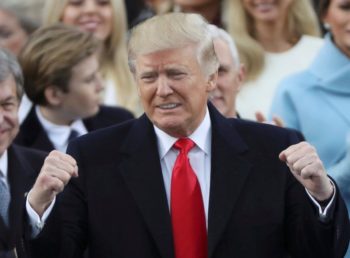President Donald Trump will sign executive orders on Monday to withdraw the U.S. from the Trans-Pacific Partnership trade deal and renegotiate the North American Free Trade Agreement, according to an official familiar with the plans.
Trump’s trade-focused executive orders, part of a series of actions planned for Monday, fulfill a campaign promise to rewrite America’s trade policy during his first days as president.
The TPP, a 12-country deal that sought to liberalize trade between the U.S. and Pacific Rim nations including Japan, Mexico and Singapore, was a signature piece of former President Barack Obama’s “pivot” to Asia. Trump campaigned against the pact and other trade deals, such as Nafta, during his campaign for the White House.
In a video released in November, Trump promised to exit the TPP deal “on day one.” He called the trade pact “a potential disaster for our country.”
Trump said Sunday that he’ll meet with Canadian Prime Minister Justin Trudeau and Mexican President Enrique Pena Nieto to begin discussing Nafta, which he has routinely blamed for the loss of U.S. jobs. The newly sworn-in president praised Mexico for being “terrific” and signaled that he’s willing to work with the U.S.’s closest neighbors.
“We’re going to start renegotiating on Nafta, on immigration, and on security at the border,” Trump said at the start of a swearing-in ceremony for top White House staff. “I think we’re going to have a very good result for Mexico, for the United States, for everybody involved. It’s really very important.”
Trade deals targeted
Trump repeatedly criticized the TPP and Nafta on the campaign trail, saying the U.S. manufacturing sector had been hollowed out by bad trade deals. Trump was scheduled to meet business executives and union leaders in two separate meetings on Monday, a day the White House cast as focused on trade and job creation.
Trump pledged during the presidential campaign that he would renegotiate the North American deal in order to improve trade conditions for the U.S. and prevent companies from shipping American jobs abroad. “If our partners refuse a renegotiation that gives American workers a fair deal, then the president will give notice of the United States’ intent to withdraw from Nafta,” according to a statement on the White House website.
After years of negotiations by both Republican and Democratic administrations, Nafta was signed by then-President Bill Clinton in 1993, and went into effect the following year. The pact sought to eliminate trade barriers between the North American countries, as well as protect intellectual property of goods.
American jobs
As far as the Trans-Pacific deal, despite Congress’s approval of “fast track” authorization for the agreement in 2015, it was never formally authorized by the U.S. Lawmakers from both sides of the aisle said they grew increasingly concerned it would result in a loss of American jobs.
The future of the TPP is now in flux. Japanese Prime Minister Shinzo Abe said in November that TPP without the U.S. would be ” meaningless.” Still, multiple signatory countries including Vietnam and Australia have said they would stick to the deal even without the leading party of the agreement.
Trump made trade one of the central issues of his campaign, which found success in the former industrial areas of states such as Wisconsin and Michigan. Both states were often considered strongly Democratic before they flipped to Trump in 2016.
In a June speech in Pittsburgh, Trump attacked the deal, which he said “would be the death blow” for American factories. “It would give up all of our economic leverage to an international commission that would put the interests of foreign countries above our own,” he said.
While some had pushed for the Congress to vote on the agreement in a lame-duck session after the election, the vote never materialized.
11th-hour push
In the final days of the Obama administration, six U.S. ambassadors in Asia attempted to push for a last-minute vote on the pact, which they said if abandoned would cede international leadership to China, which isn’t a part of the TPP. “Such an outcome would be cause for celebration among those who favor ‘Asia for the Asians’ and state capitalism,” the ambassadors wrote in a letter.
Rather than support wide-ranging regional trade agreements, Trump has proposed negotiating bilateral trade agreements. He has also proposed enacting tariffs on imports to protect domestic manufacturing.
Source: Bloomberg
Copyright Ships & Ports Ltd. Permission to use quotations from this article is granted subject to appropriate credit given to www.shipsandports.com.ng as the source.

